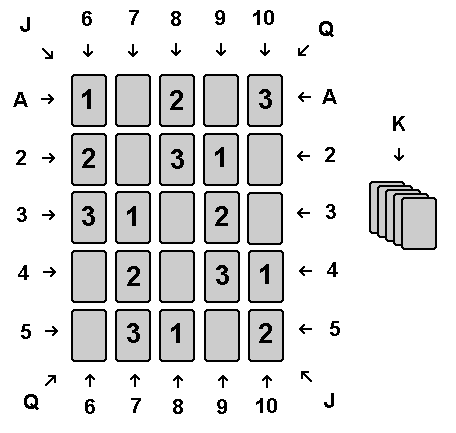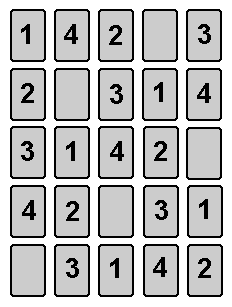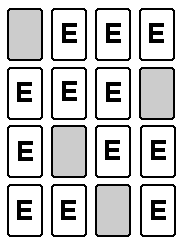King's Pot
Contributed by Alan Kross-Vinson - see also the variations:
This is a game based on poker hands for 3 to 22 players using a regular 52 card deck. Aces are normally high, but can be low in straights.
The dealer deals 25 cards face down to a 5x5 grid: 5 rows and 5 columns, and then deals 5 more cards face down in one pile to the side. The 5x5 grid makes twelve 5-card poker hands; each row, each column, and each diagonal. The first row is referred to as "ace's hand", the second row is "two's hand" etc to the 5th row which is "five's hand". the first through fifth column is "six's" through "ten's" hand. The northwest-to-southeast diagonal is "jack's hand", the other diagonal is "queen's hand".The extra pile of 5 cards is the king's hand. See diagram.

The rows, columns and diagonals of the tableau may be marked with cards from another deck, to identify them.
After dealing the tableau and king's hand, 22 cards remain. Each of the players in turn chooses how many of these cards they want to be dealt, up to a maximum depending on the number of players, and pays an agreed ante amount for each card they ask for.
- If there are 3 players, each can buy up to 7 cards;
- 4 players, up to five cards;
- 5players, up to 4 cards;
- 6 or 7 players, up to 3 cards;
- 8,9,10, or 11 players can have one or two cards;
- over 11 players, each may have only one card.
To play, though, you need only one card.
These antes that are paid for dealt cards go to the king's pot, which is placed near the king's hand.
Each player is dealt the number of cards they paid for. These card(s) determine which hand(s) (the corresponding row, column or diagonal) the player will be betting on.
The five cards marked "1" in the diagram above are are now flipped over face up, so that one card of each hand except for the king's hand is known. A round of poker betting follows, beginning with the player to the left of the dealer. This money is placed in a pot separate from the king's pot. Each player may check, bet, call, or raise as usual, staking the required amount for each card they hold. They may fold any or all of their cards - folded cards are removed from the table and no stake is placed for folded cards.
Now the five cards marked "2" in the diagram are exposed, so that two cards of each hand from ace to queen are known, and there is another round of betting.
Finally the five cards marked "3" are exposed, so that three cards of each hand from ace to queen are known. There is a third round of betting, followed by a showdown if more than one player has stayed in.
In a showdown, all cards of the tableau and the king's hand are exposed and the players show the cards they have not folded. The players' cards represent which hand(s) they are playing. The winning hand is the highest hand that is represented by a card held by a player who has remained in the game. This may not be the highest hand on the table. Players holding equal ranked cards that represent the winning hand split the pot.
If the king's hand is the winning hand, the player collects both pots. If the king's hand is not the winning hand, the king's pot remains, and grows by each game's antes. Eventually, this pot grows so large that anyone holding a king will likely remain until the end, to have a chance of winning the king's pot.
Note:none of the king's cards are exposed until the showdown.
Special note:a player playing more than one card may receive more than one card of the same rank. One would reasonably be expected to fold one of these cards immediately, so as not to have to bet twice on the same hand. However, if that card's hand wins and the pot is split with another player holding only one card of that rank, the holder of two cards would collect two-thirds of the pot.
King's Pot Optional Play
In this variation of King's Pot, rather than revealing one, two, and three cards in each line, start the first round of betting by revealing two cards in each line (10 cards total). Reveal the third card in each line (5 more cards) for the second round, and reveal a fourth card in each line for the final round of betting. The position of these fourth cards is shown is the following diagram.

Texas Dozen
This is a Texas Hold 'em variation using the 5x5 layout used in King's Pot. 2 to 13 players. This gives players 12 options (5 columns, 5 rows, 2 diagonals) to use with their two hole cards. It is played like Texas Hold 'em, except the deal starts with 25 cards dealt to a 5x5 pattern face down, and two cards dealt to each player, followed by the first round of betting. Then, the flop is exposed by revealing all the cards numbered 1, 2 and 3 in the above diagram. Players do not need to commit to any particular line of cards. Second round of betting occurs, then the Turn cards are exposed: these are cards numbered 4 in the above diagram. Round of betting, then the remaining cards (the river) are exposed before the last betting round and showdown. On the showdown, players declare which one of the 12 lines (column, row, diagonal) they are using to form their hand.
Off-Road Stud
This game continues with the theme of giving each player multiple options with which to match their hole cards. 2 - 12 players. Start by placing 16 cards on the table in a 4X4 arrangement. This makes ten lines of four cards: four columns, four rows, and two diagonals - see diagram.

The cards marked 'E' are exposed, the others face down. Then deal each player two hole cards. Here, the first round of betting occurs. Players are attempting to match their hole cards with one of the ten lines of cards to form the best poker hand. Players need not commit to any particular line of cards at this point. Next, a third hole card is dealt to each player, followed by another round of betting. Finally, the four face-down cards on the table are exposed, and the last round of betting occurs. Players declare which one of the ten lines they are using to make their hand on the showdown.